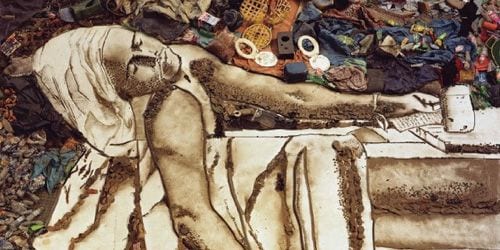
Brazilian artist Vik Muniz made a name for himself in the New York art scene with his portraits constructed of unexpected materials like sugar, chocolate syrup, bits of trash, and dirt. His efforts got exhibited in New York’s Museum of Modern Art, but that wasn’t enough.
A restless, energetic sort, Muniz was casting about for his next big project when he came upon a unique idea. He would travel to Jardim Gramacho, the world’s biggest garbage dump, just outside his hometown of Rio de Janeiro. There he would photograph the pickers who trawl through the trash, looking for the recyclable materials that earn them and their families $20-$25 per day. Muniz’s idea: use those materials to replicate the portraits of the workers themselves. His notion was “to change the lives of a group of people… using the materials they use every day.”
The film follows this project over the three years that it takes ro conceptualize, organize and carry it out, and along the way the audience meets a band of charismatic, energetic characters: labor organizer Tiao, bibliophile Zumbi, single moms Suelem and Magna, dignified and philosophical Valter (a picker for 26 years), fragile Isis and powerful Irma, who provides workers with food and drink. The film is careful to avoid patronizing the workers, who tell their own stories, some of which are heartrending.
Muniz’s preconceptions are quickly challenged—before he flies to Brazil, he tells his wife that the workers “are all drug addicts”, which does not seem to be the case. “This is where everything that is not good goes,” he says, “including the people.” In fact, many of these workers proudly claim to be doing an important job that they wouldn’t change for anything else, although by the end of the film, that brave assertion is largely undermined.
Muniz and his righthand man Fabio earn the trust of the workers, who live and work in appalling conditions. The artist arranges photo shoots within the confines of the landfill, a place which is simultaneously stomach-turning and meticulously organized. A series of portraits is taken, and then in an enormous warehouse studio, the portraits are projected onto the floor. Workers use sorted garbage material—PVC piping, aluminum cans, colored glass, toilet seats—to recreate the images on a huge scale. Once complete, these mosaics of trash are then photographed again, finally printed as six-foot-tall portraits which are striking in their power.
So then what? To its credit, the film does not shy away from asking the question: what are these workers supposed to make of their new status as art celebrities? Muniz accompanies one of the pickers to London in hopes of auctioning his portrait, and the rest of the group become local celebrities in Rio, but the experience raises pertinent questions as to the transformative power of art. Is it better to offer a glimpse of another, presumably better way of life, even if it can only be experienced fleetingly? Or, as Muniz’s wife Janaina would have it, is it irresponsible to hold out the promise of something that cannot be fulfilled?
Indisputibly, the workers have undergone an experience that has changed them. But the viewer has to wonder, as Isis breaks down in tears and begs Muniz to keep her away from the landfill, whether this change is better for them in the long run.
Ultimately, Muniz decides that art can do no harm—that going through a life-changing experience, even one that might leave a bitter aftertaste, is better than not going through it at all. The audience is inclined to agree, especially as most of the workers seem to come out the other side in somewhat improved circumstances. But the issue is far from definitively settled, especially in light of some postscripts at the very end of the film.
Like any good documentary, Waste Land tells a compelling story even as it raises questions for the audience to mull. That it manages to do so with a minimum of condenscension to its subjects is admirable.
This disc contains 28 minutes in bonus features, including the mini-doc “Beyond Gramacho”, which checks in on how some of things have changed for the pickers since the documentary was made. “An Untold Story”, focuses on the process of how the particular workers were selected for the film, and relates the story of one whose story and portrait was removed from the final cut of the film.

![Call for Papers: All Things Reconsidered [MUSIC] May-August 2024](https://www.popmatters.com/wp-content/uploads/2024/04/all-things-reconsidered-call-music-may-2024-720x380.jpg)



